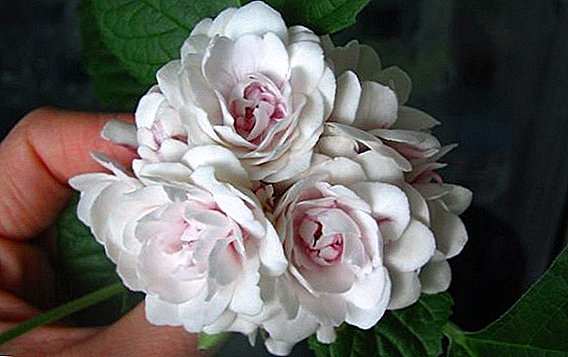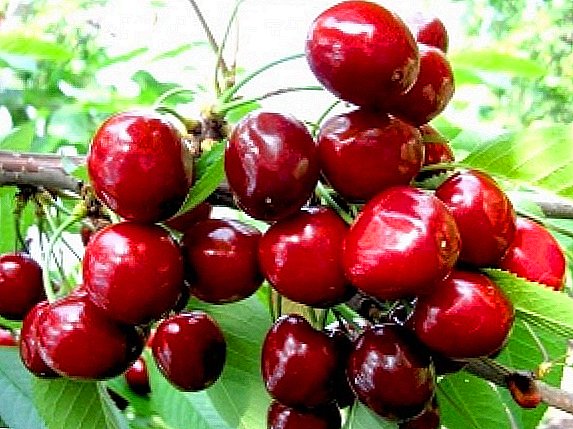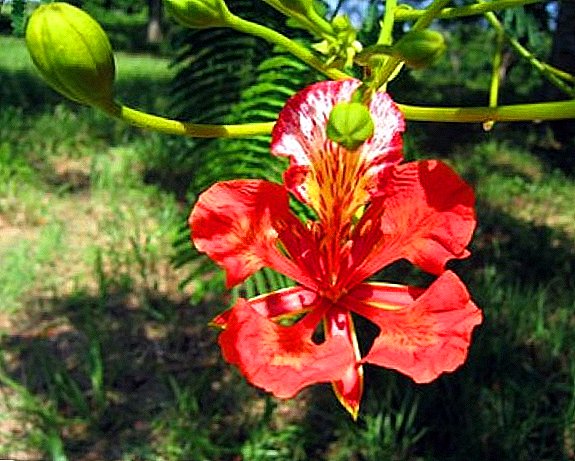 Among tropical plants, the top five most beautiful includes delonix, or rather - Royal Delonix. No matter how they call it: fire tree, fiery tree, phoenix tail, fiery tree, tree-flame. And indeed, the tree looks that way, thanks to the bright red colors.
Among tropical plants, the top five most beautiful includes delonix, or rather - Royal Delonix. No matter how they call it: fire tree, fiery tree, phoenix tail, fiery tree, tree-flame. And indeed, the tree looks that way, thanks to the bright red colors.
Royal tree
Truly delonix - royal tree. It has a sprawling crown, and during the flowering period is painted red.
Did you know? Royal Delonix was discovered by a Czech botanist and naturalist Wenceslas Boer in the town of Fulpunt in the east of Madagascar.
The plant belongs to the family of legumes and the subfamily Caesalpinia. In height reaches 10-20 meters. It grows very quickly: up to 2.5-3 m per year. The trunk is thick, with smooth light bark in young plants and brown spotted in old ones. The older the tree, the thicker the trunk and more flowers. The krone is very sprawling, umbrella-shaped. The roots go very deep, so the tree can withstand strong gusts of wind. It has green fern leaves up to 40 cm. It is considered an evergreen culture.  It is interesting that at night the leaves fold and become almost imperceptible. If you light a tree, it seems that it is burning.
It is interesting that at night the leaves fold and become almost imperceptible. If you light a tree, it seems that it is burning.
The legume family includes such trees as: acacia, cercis, mimosa, caraganum, wisteria, and bobovnik.
It blooms in a warm climate in May-July, the flowers are scarlet (may be yellow in other species of Delonix). Fruit - pods up to 55 cm long. At first they are the color of the bark, then brown, mature black. In the pod - 20-30 fruits, some of which are poured out in wet weather.  The plant is drought-resistant, but very gentle with respect to temperature conditions. In a drought, to save moisture, can partially or completely shed the leaves. Maintains temperature not lower than -1 ° С. Otherwise, it perishes.
The plant is drought-resistant, but very gentle with respect to temperature conditions. In a drought, to save moisture, can partially or completely shed the leaves. Maintains temperature not lower than -1 ° С. Otherwise, it perishes.
Propagated by seed, rarely - cuttings.
Did you know? In vivo, the delonix multiplies by seeds that are eaten by animals, are not digested and fall into the ground with feces. Seed preparation for germination is performed in an optimal culture for the warm and humid environment of the intestine of the animal (pigs, cows, etc.).
Motherland of Delonix
Royal Delonix fiery comes from Madagascar, but nowadays it is extremely rare. It grows in warm countries with a tropical climate. It is used for landscaping streets and parks. Today, the “fiery tree” can be seen more and more often in squares, parks, lawns, landscape design compositions and other areas with a suitable climate.
The plot can be decorated with such ornamental trees as: sea buckthorn, red oak, arbutus, holly, Japanese maple.
In the wild, it is almost completely destroyed, because other plants do not survive in its shadow at all. The extermination of the species occurred also because its wood belongs to strong valuable species.  The cold climate is not an obstacle to the cultivation of the royal Delonix. It perfectly adapts to home conditions in any climate.
The cold climate is not an obstacle to the cultivation of the royal Delonix. It perfectly adapts to home conditions in any climate.
Does it grow in Russia and Ukraine
In Russia, royal delonix grows only where the climate is close to tropical. Thus, on the territory of Russia and Ukraine, it cannot grow in open ground, because it does not tolerate not only frost, but even weak frosts. But it is widely distributed as a kadochny plant or tree for greenhouses.
Delonix tolerates pruning. Therefore, you can form a crown no higher than 2-4 m. You can also form a bonsai. 
Growing at home
Royal Delonix at home is very well suited for the "winter garden", where the temperature does not fall below 12-15 ° C. In addition, if you choose a tub method of cultivation, this evergreen tree will decorate your yard in the summer and the living room in the winter.
In optimal home conditions, blooms on the 4th year. Moreover, the duration of flowering compared with the "street" option increases. It blooms from May to September. 
Important! Delonix Royal is poisonous for dogs.
Choosing a place
Learning how to grow a royal Delonix at home is easy, thanks to amateur flower growers forums. This question is already well studied.
Delonix is not picky about the soil. It will grow on any light and loose soil with good drainage. The plant is very light-loving, loves direct sunlight. Therefore, in the "winter garden" or greenhouse planted on the south or south-west side. The apartment or house must be placed at the south-west or south window. If these sides of the world are not available - additional lighting will be required.  When the spring tub with the plant is taken out on the street, it is determined in the sunniest place of the yard. It is possible to take the plant outside when the lower threshold of night temperature reaches 12-15 ° C. Before - it is impossible, it can suffer.
When the spring tub with the plant is taken out on the street, it is determined in the sunniest place of the yard. It is possible to take the plant outside when the lower threshold of night temperature reaches 12-15 ° C. Before - it is impossible, it can suffer.
Seed preparation and planting
As already mentioned, the plant most often propagates by seed. At home, cuttings, as a rule, do not germinate. Seeds can be easily purchased in specialized stores or ordered from a reliable seller via the Internet.
Before planting, some seed preparation will be required so that the seedlings appear quickly and are resistant to external negative factors. Before planting, seeds should be dipped in boiling water for 1-2 minutes, then soak in warm water for a day. Should be planted in a wet sand mixture, after - cover with foil. The sand mixture should consist of sand and sod land in a 1: 1 ratio. To create natural conditions of germination, the pot must be in a room with a temperature not lower than + 28 ° C.
To accelerate germination, seeds can be scarified, i.e., a strong shell can be opened so that the sprout can easily come out. Shoots appear within a month.
Did you know? Delonix beans are used to make percussion instruments and rattles from natural material.
Sprout care
When the plant has risen, the most difficult thing is to save the sprout. The main thing at this stage - watering. Here it is important and not to pour, and not to make out. Watering should be fairly moderate as the soil dries, but at the same time, the ground should dry out a little. If you miss watering, the plant can throw off the leaves.
In addition, sprouts are still weak and may not be exposed to direct sunlight. Therefore, they must be kept under shaded sunlight: and does not burn, and heat.
Young royal delonixes need to be replanted annually. First, the pot, and then the tub must be of sufficient size, high, since the fiery tree has a strong root system.
Rules for caring for an adult plant
Adult plant unpretentious. Like conventional crops, it requires irrigation, pruning, partial change of land, and fertilization.
Watering moderate. The soil under the tree should periodically dry out well. Perelivov plant does not like. In winter, during the period of rest, watering should be reduced to a minimum. The resumption of moderate watering in spring stimulates the flowering of adult trees. Excessive soil moistening in winter will simply ruin the delonix.  Air humidity for a tree is also important. In hot weather, the crown can be sprayed with water, as well as put a container with it near the pot or tub.
Air humidity for a tree is also important. In hot weather, the crown can be sprayed with water, as well as put a container with it near the pot or tub.
Important! Water in no case should not fall on the flowers - they immediately die.
Partial replacement of land involves only the annual change of the upper layer. Here you have to choose the land carefully, so as not to damage the roots.
Top dressing - from March to September by usual fertilizer; first for decorative leafy, then for decorative flowering plants. Feed up better, combining with watering.
Pruning delonix easily transfers any: superficial and deep, crown and root. It is best to cut the plant to form the crown and roots after flowering, when the tree goes into a dormant period. If you need, you can trim an extra branch at any time.
The plant will bloom if you provide it with optimal climatic conditions: temperature, watering, sun. 
Diseases, pests and other difficulties
Among the diseases of the royal delonix most common are the sheath and spider mite. To combat them in the gardening shops sold a special tool. They need to spray the ground part of the plant - and the problem is solved.
The shield can even be assembled by hand. If the plant is still small - it is not difficult.
In addition to pests, there is another problem. The tree grows very quickly, so it requires constant monitoring of the crown. If you want the plant to look well-groomed (especially if it is a bonsai), inspect the crown weekly and prune the excess shoots.
For bonsai, such plants as: laurel, Benjamin's ficus, evergreen boxwood, thuja, ficus mikkarpa and strawberry tree are excellent.
 The tree is unpretentious, and if your choice fell on him, you will not get much trouble. The plant is beautiful and in flowering form, and at rest. Royal Delonix will not leave indifferent any amateur grower.
The tree is unpretentious, and if your choice fell on him, you will not get much trouble. The plant is beautiful and in flowering form, and at rest. Royal Delonix will not leave indifferent any amateur grower.












